Analysis of Collaborative Governance of Network Public Opinion in Social Circles Based on Blockchain Traceability Strategy: An Evolutionary Game Theory Approach
Abstract
In the context of rapid development of social networks, users gather together through social network platforms (SNPs) to form social circles, which become the main carriers for users to disseminate public opinion information and emotions, and it is easy to form the phenomenon of network public opinion polarization in social circles. To prevent the polarization of network public opinions in social circles, the application of blockchain technology to SNPs can provide a credible database for the traceability of public opinions and avoid the spread of false information in social circles. Based on blockchain traceability, this paper establishes a three-party evolutionary game model consisting of government, SNPs, and social circle managers (SCMs). Through model solving and numerical simulation, the influencing factors of each party’s strategy are analyzed. The findings suggest: (1) Although the rising cost of building blockchain platforms may undermine the government’s incentive to regulate, the government will still prioritise support for their construction if they can significantly enhance social welfare. (2) The government could boost SNPs’ willingness to adopt blockchain technology through subsidy measures, but increased privacy risks could undermine this willingness. (3) Blockchain technology realizes the traceability of public opinion and improves the rational guidance tendency of SCMs. Therefore, in order to promote and strengthen the collaborative governance of network public opinion in social circles, SNPs should enhance the use of blockchain technology, while the government should give full play to its regulatory and supervisory roles. This study introduces blockchain technology for public opinion traceability; explores a collaborative network public opinion governance system based on strict regulation by the government, introduction of blockchain technology by SNPs, and rational guidance by SCMs; expands the related research on network public opinion governance; and provides a new idea for the study of network public opinion governance of social circles based on blockchain traceability.
1. Introduction
With the widespread use of digital technologies such as smartphones, the Internet, and mobile Internet in public life, the amount of data generated by human beings every day has increased exponentially, leading to dramatic changes in the form and speed of information dissemination [1]. However, open but anonymous social network platforms (SNPs) provide a cyberspace for the public to freely express their emotions and opinions, thus enabling the rapid dissemination of huge amounts of information, and the dissemination of misinformation may have a deleterious effect on social stability, that is, negative network public opinion [2].
Social circles are an important expression of modern social culture, mediated by SNPs, such as WeChat, Twitter, and Weibo, which combine an individual’s real-life circle with a specific cause to form an aggregated cyberspace, in which users can exchange their life experiences, share opinions, discuss current controversial topics, and build their discourse capacity [3]. However, information in social circles spreads virally and can lead to a dramatic increase in the heat of public opinion. For example, in the incident of Tesla’s brake failure, a netizen with seven million followers released inaccurate information to malign the product quality and reputation of the Tesla enterprise, and even though the official organization has issued relevant clarification announcements, many users still show negative emotions in their forwarding and commenting behaviors, so that the inaccurate information spreads rapidly on the SNP, resulting in serious losses for the enterprise. Compared with the traditional form of network public opinion, public opinion in the social circle shows the characteristics of strong aggregation [4], strong boundaries [5], and collective unconsciousness [6]. Meanwhile, rumors, negative emotions, and false information, once spread, will be spread in the closed social circle, which will produce a more serious phenomenon of public opinion polarization [7]. Therefore, the problem of public opinion governance in the social circle should be governed from the source of communication, to curb the generation of inaccurate public opinion from the source, so as to avoid the fermentation of negative public opinion to the extent that it is difficult to govern. Social circle managers (SCMs) are important opinion leaders in the social circle, because they usually understand the events faster and share their opinions and attitudes with the users in the social circle, thus influencing others’ opinions about the events, and gradually become the guide of public opinion in social circles [8]. The communication behavior of SCMs in social circles not only promotes the spread of network public opinion but also influences the direction of public opinion dynamics [9]. However, it is not uncommon for false information to appear on social networks, which can prevent SCMs from correctly guiding public opinion, implicitly affecting public opinion, and threatening social development [10]. Therefore, it is further exacerbated by the difficulty of ensuring the credibility of the source of information and tracing its origin [11], which seriously hampers the governance of network public opinion in social circles.
How to verify the veracity of public opinion data has been the subject of numerous scholarly investigations [12–14]. Actually, tracking public opinion and achieving traceability of public opinion data with blockchain technology can greatly aid in streamlining network environment management procedures [15]. Blockchain is a distributed ledger technology that links transaction data in blocks to create an immutable and transparent data chain using consensus procedures and cryptographic algorithms [16]. A number of characteristics define blockchain technology, such as traceable information, transparent and open processes, and safe and dependable data storage [17]. Because of these characteristics, blockchain technology can offer a very safe and integrity-preserving method of transferring and storing data, all the while guaranteeing that all involved parties are fully aware of the process’s status and result. Therefore, blockchain technology can offer comprehensive solutions to various industries by providing secure, transparent, and immutable data records. Blockchain technology has proven over time to be an effective solution to the data traceability issue by offering a safe, transparent, and unchangeable record of data that has been utilized in many different sectors, such as healthcare [18–20], supply chain management [21–23], finance [24–26], and others. Furthermore, blockchain technology is decentralized and can build cooperative trust and consensus among multiple subjects, which is ideal for the highly decentralized field of public opinion and is expected to bring revolutionary innovations to the governance of network public opinion [27].
The complexity of the interactions between various subjects is ignored in current research on the governance of network public opinion in social circles, which concentrates on the role of individual influence [28]. Social and technological factors interact and influence one another during the complicated and dynamic process of forming and disseminating network public opinion, which ultimately leads to the outbreak and fermentation of network public opinion [29]. Some scholars have introduced the game theory perspective to study the role of the participating subjects of network public opinion on opinion governance, such as the effectiveness of opinion leaders in guiding public opinion [30], the best time for governmental control [31], and the significance of SNP regulation [32]. By analyzing the strategy evolution of various participating subjects, this research method can reveal the mechanism of influence on the formation and development of public opinion. It can also enrich theoretical understanding of the dynamic evolution of public opinion, objectively understand the dynamic process of public opinion management, and provide references for public opinion governance strategies. Therefore, a thorough analysis of the collaborative governance approach of network public opinion is required, with the involvement of the government, SNPs, and SCMs, taking into account the application of blockchain technology to traceability of public opinion and from the perspective of game theory.
Based on the above analysis, this paper constructs a three-party evolutionary game model, explores the strategy evolution and game process of network public opinion participants in social circles using evolutionary game theory, and ensures the visibility and reliability of public opinion information by combining with blockchain strategy. Through modeling and simulation, the evolutionary trend of participants’ behaviors and game results under different strategies can be studied in depth, and the practical application effect and impact of blockchain technology in public opinion management can be analyzed. In addition, the mechanism of the influence of blockchain technology on participants’ decision-making behavior in public opinion management can be revealed, further expanding the research scope of public opinion management in social circle networks. These studies provide new theoretical perspectives and solutions to the complex public opinion problems faced today, which can help improve public opinion management strategies and enhance the health and stability of the social information environment.
The rest of the thesis is as follows: Section 2 provides a review of the relevant literature. Section 3 details the modeling steps of the evolutionary game model. Section 4 analyzes the stability of the strategies of different participating subjects and solves the evolutionary stable strategy (ESS) points. Section 5 provides an in-depth analysis of the model through numerical simulation methods. Finally, Section 6 provides a comprehensive summary of the experimental results and theoretically puts forward management suggestions for promoting blockchain technology in the collaborative governance of network public opinion in social circles, with a view to providing guidance and insights for practical applications.
2. Literature Review
2.1. Network Public Opinion in Social Circles
With the development of social media and the flourishing of virtual socialization, people are constantly switching between physical space and online living space, and it has become the norm for individuals to engage in social interactions through online social media. This trend has led to the gradual detachment of Internet users from the real society and the formation of a unique form of online collective existence. At the same time, with the development of Internet technology, many emerging virtual communities with strong cohesion have emerged. Academics refer to these emerging communities as “social circles” and have studied them extensively. Regarding the definition of social circles, different scholars have different definitions. Analyzing from the perspective of cyberspace development, Yang and Jiang argue that social circle is a new type of group that emerges with the development of online communities and is a form of online community evolution [33]. Choudhary, Minz, and Bharadwaj cuts through the perspective of social relations and argues that social circles are cyberspaces formed by the aggregation of interests, exchanges, and interactions [34]. Xiao, Aung, and Tan cut in from the perspective of social media, arguing that social circles are a specific product on the social media platform, which carries the main function of network information and emotion transmission in the new media environment [35].
It is challenging to control network public opinion in social circles, and existing literature examines how the interactions of individuals in social circles influence the direction of network public opinion. Bruine de Bruin et al. investigated and analyzed social circles and found that people’s social relationships and social circles have a significant impact on political attitudes and voter behavior, and that voter support and attitudes towards different political parties can be better understood by understanding the patterns of social connections and information dissemination between individuals [36]. Stępień et al. proposed a mathematical model based on the dynamics of social networks and public opinion in order to study the mechanisms and results of conformist behavior in social circles, which showed that individuals tend to be influenced by the opinions and behaviors of other people in their social circles, which leads to the phenomenon of conformist behavior [37]. Zheng et al. argued that there are similar interests, opinions, and behavioral patterns among members of social circles, and this homogeneity can be used to identify potential rumor spreading and detect rumors on social media by mining social circles with high homogeneity [38]. Lu, Wang, and Ye emphasized the importance of user intimacy and social circle differences in influencing topics, arguing that by taking into account the level of intimacy between users and the differences between different social circles, users’ attitudes and behaviors towards specific topics can be more accurately analyzed [39].
2.2. Traceability of Public Opinion Based on Blockchain
Blockchain technology is a distributed ledger technology that ensures the security and trustworthiness of data through encryption and consensus algorithms, and it uses blocks to record transaction information and connects these blocks through a chain structure to form a tamper-proof data recording system [40]. Although blockchain technology still faces challenges such as scalability and privacy protection, it has a wide range of applications in finance, logistics, supply chain management, and other areas, and it is considered a technology with revolutionary potential [41].
In the face of continuously fermenting network public opinion, responding to a public opinion crisis is not simply a matter of calming down public opinion, but tracing the root cause is one of the most important methods [42]. By sorting out the development of public opinion events, it can help the relevant departments understand the development route of public opinion and find the key nodes, so as to discover the reasons that drive the outbreak of public opinion events, and provide useful references for subsequent research, guidance, and disposal work [43]. Most of the current traceability methods for network public opinion information use complex network traceability techniques. This method achieves the traceability of network public opinion by constructing an information diffusion model and analyzing data such as multidimensional attributes and remarks before and after the occurrence of public opinion events. Wu et al. hypothesized the connection between social media users and social network structures and used LSTM-RNN to represent and classify message propagation paths [44]. Feizi et al. proposed a method called network infusion (NI), which fuses attributes such as text features, content relevance, and comment posting time to construct an information dissemination model, which is proved by experiments to be effective in optimizing and calculating the source of information dissemination [45]. The traceability methods mentioned above require a large number of complex calculations, may affect the traceability results because of risks such as data loss and tampering, and do not guarantee the timeliness and credibility of the traceability. In contrast, the chain structure of blockchain itself supports information traceability, is concise and efficient, and based on distributed storage, consensus algorithms and hash algorithms can effectively prevent data from being tampered with, which can ensure the reliable storage of public opinion data. Sun et al. propose a new social network opinion dissemination model based on blockchain technology to construct the revenue-risk matrix under different dissemination behaviors, which helps to improve the efficiency of online opinion management and curb the dissemination of false information using blockchain technology [46]. Shang et al. combined blockchain technology and integrated the blockchain traceability mechanism into news dissemination to achieve traceability and prevent tampering, thus effectively combating fake news [47].
2.3. Evolutionary Game Theory
Game theory was introduced by von Neumann and Morgan Stern in the mid-20th century [48], and evolutionary games are based on game theory, which incorporates Darwinian concepts when considering frequency-dependent adaptation, thus introducing a strategy element to the evolutionary process [49]. Unlike game theory with finite rationality of participants, evolutionary game theory is used to analyze decision problems with interdependence between finite rational individuals [50].
In different fields, scholars have developed many dynamic models based on evolutionary game theory to study how interacting groups of individuals change their behavior over time. Garde et al. analyzed the behavior of a single-cell, social-organic community under three antibiotic pressures based on an evolutionary game theory model [51]. Falster and Westoby investigated the competition and coexistence of plant height strategies using evolutionary game theory, which is based on the phenomenon that the height benefits of a plant are related to the presence of other height strategies [52]. Ji, Ma, and Li used evolutionary game theory to study the green purchasing relationship between manufacturing firms and their suppliers, and found that the manufacturing industry can develop a sustainable model and that the recycling ability of suppliers directly determines the greenness of the supply chain [53]. Some scholars have also applied evolutionary game theory to the field of network public opinion. Qiu, Yuan, and Yin proposed a three-party evolutionary game model involving social network providers and found that the government’s formulation of reasonable incentives and penalties can promote the participation of social network providers in network public opinion governance [54]. Yang and Zhou proposed a game model for the governance of the online audiovisual space, showing that the radio and television administrations can effectively govern the ecology of public opinion by strengthening the supervision of online audiovisual content creation through government regulation and warning campaigns against vulgar creations [55].
2.4. Summary
By combing through the relevant literature, this paper summarizes the existing studies. First, most scholars achieve the purpose of controlling network public opinion by deeply studying the role of individuals in social circles but neglect the way of collaborative governance by multiple subjects. Second, existing studies mostly adopt the evolutionary game approach to analyze the strategic choices of different subjects in the process of public opinion dissemination but adopt the cooperative game approach to a lesser extent to explore the collaborative governance behaviors among each other and the distribution of their benefits. Finally, most researchers only focus on the impact of information traceability technology after its application in network public opinion but ignore the game behavior between related subjects in network public opinion governance based on information traceability strategy. Therefore, based on the above analysis, this paper constructs a three-party evolutionary game model including the government, SNPs, and SCMs; analyzes the evolutionary stabilization strategy of collaborative governance of network public opinion in social circles; and explores the role of blockchain technology in collaborative governance of network public opinion and puts forward corresponding suggestions.
3. Construction of Tripartite Game Model of Collaborative Governance of Network Public Opinion in Social Circles
3.1. Stakeholders
Government, as the coordinator of public opinion governance, encourages and supervises SNPs and SCMs to participate in public opinion governance. During the evolutionary game, the government will provide SNPs with blockchain-based public opinion traceability technology and supervise SCMs’ words and actions in social circles, with positive or passive governance strategies. When the government chooses positive regulation, the government provides subsidies to SNPs for their use of blockchain technology in order to encourage them to use blockchain technology for public opinion traceability [55]. At the same time, the government will support SCMs to speak out rationally within their social circles to guide platform users from being deceived by false information [56]. Under active regulation, in addition to the above incentives, the government will also control the vocal behavior of SCMs. When the government effectively manages and guides SCMs, prompting them to play a positive role in public opinion dissemination, the social opinion ecology may be healthier and more stable; on the contrary, if the game between the government and SCMs is unbalanced, it may lead to a situation of public opinion chaos, social instability, or even political turmoil. Therefore, the government will play its regulatory function and penalize SCMs that disturb the social opinion ecology to create a good public opinion ecology and establish the image of social credibility [57].
SNPs, as providers of social network platforms, are constrained and regulated by the government on the one hand, and face the risk of platform ecological deterioration on the other. The government may restrict and regulate SNPs through laws and regulations, regulatory agencies, and technical requirements. For example, platforms are required to review user-generated content to prevent the spread of false information [58]. Such regulation is not only to protect public interest but also to ensure that social networks do not have a negative impact on society in their operations. It is an innovative application for SNPs to utilize blockchain technology for public opinion traceability to support SCMs for public opinion governance. The use of blockchain technology can make the rights and responsibilities of SCMs clearer and more explicit, and they can base on real data recorded by blockchain to make public opinion governance and decision-making in a more evidence-based manner [47], and to enhance management effectiveness and social influence.
SCMs, as key figures in social circles, have platforms for influence and information dissemination [8]. They may try to maintain their power and status by controlling the spread of information and guiding the direction of public opinion. Therefore, through regulatory measures, the government may prompt SCMs to consciously comply with laws, regulations, and industry guidelines to enhance their sense of responsibility and compliance, while SNPs may trace the source and dissemination path of the information through blockchain technology to verify the authenticity of the information, thereby reducing the dissemination of false and misleading information. This helps establish a positive and healthy information dissemination environment, which is more favorable to social development and public interest.
Current research indicates that the governance of network public opinion is related to many subjects, such as government [1, 54], opinion leaders [59, 60], etc., but very few take SNPs as a party to the game, and the research on collaborative governance of network public opinion is still limited. It is worth noting that we also consider the blockchain-based opinion traceability technology as a choice of strategy, which will improve the efficiency of network public opinion governance to some extent. In the collaborative governance system of network public opinion in social circles, the government funds the research and development of blockchain technology and strictly regulates SNPs and SCMs. SNPs can pay to use blockchain technology for public opinion traceability, and SCMs can obtain public opinion-related event information and rationally guide public opinion through SNPs, and each of the three pursues different interest goals and has different value demands. The specific analysis is shown in Figure 1.
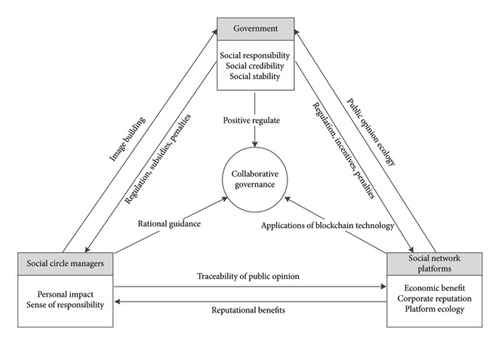
3.2. Model Assumption
-
Hypothesis 1: The probability that the government chooses a “positive regulation” strategy is denoted by x (x ∈ [0, 1]), and 1 − x represents the probability of choosing a “negative regulation” strategy. Similarly, the probability that SNPs choose the “blockchain” strategy is denoted by y (y ∈ [0, 1]), and 1 − y represents the probability of choosing the “no blockchain” strategy. The probability of SCMs choosing the “rational guidance” strategy is denoted by z (z ∈ [0, 1]), and the probability of choosing the “irrational guidance” strategy is 1 − z.
-
Hypothesis 2: The government funds the research and development of blockchain technology at a cost denoted by Cp. Cs represents the cost to the government of implementing regulatory measures. In the case where the government positively regulates and SNPs choose not to adopt blockchain technology, the government will receive the main W1 image benefit. If SNPs use blockchain technology, the government will grant SNPs a subsidy E and receive an image gain of a1W1, where a1 is the regulatory efficiency factor. The cost of negative government regulatory measures is not taken into account. In the event that the government regulates negatively and the SNPs decide to use blockchain technology, the government will only lose its reputation because of regulatory inefficiency as W2. However, if the SNPs do not adopt blockchain technology, the government’s reputation will be severely damaged as a2W2, where a2 is the regulatory inefficiency coefficient.
-
Hypothesis 3: If SNPs do not use blockchain technology, they have a basic revenue of R but incur image and reputation loss of K. However, if SNPs use blockchain technology, they incur an additional cost of Cb but gain an additional revenue of bR because of the traceability of public opinion, where b is the coefficient of avoiding negative public opinion. In addition, SNPs need to bear the privacy risk V associated with the use of blockchain technology.
-
Hypothesis 4: In the case that SCMs do not lead irrationally, SNPs use blockchain technology to record public opinion information and track public opinion events, which can improve SCMs’ understanding of the process of the event, thus reducing the cost of manpower and the cost of searching work. The cost of secondary guidance of public opinion for SNPs is L1 when SNPs use blockchain technology, but the cost is increased to L2 when they don’t use blockchain technology, with L2 being higher than L1.
-
Hypothesis 5: Assuming that the participation cost of SCMs is P, if SCMs guide users rationally in their social circles, the government will obtain a positive socio-ecological benefit of F1, and SNPs will obtain a reputational benefit of Q1. If the government positively regulates and SNPs use blockchain technology, SCMs will experience the support benefit of (1 + g1 + g2)U1. However, when SCMs irrationally guide users in their social circles, the government will penalize SCMs accordingly as U2 and jU2(j > 1) depending on whether SNPs use blockchain technology, at which time the government will experience a negative socio-ecological loss of F2, and SNPs will experience a reputational loss of Q2.
3.3. Tripartite Evolutionary Game Model
Based on the different strategy choices of the government, SNPs, and SCMs, eight strategy combinations are obtained, and the returns are calculated to build a tripartite return matrix, as shown in Table 1.
| Strategy | Government | SNPs | SCMs |
|---|---|---|---|
| (Positive regulate, blockchain, rational guidance) | a1W1 + Cb + F1 − Cs − Cp − E | E + (1 + b)R + Q1 − Cb − V | (1 + g1 + g2)U1 − P |
| (Positive regulate, blockchain, irrational guidance) | a1W1 + Cb + jU2 − Cp − Cs − E − F2 | E + (1 + b)R − Cb − Q2 − V − L1 | −jU2 − P |
| (Positive regulate, no blockchain, rational guidance) | W1 + F1 − Cp − Cs | R + Q1 | (1 + g1)U1 − P |
| (Positive regulate, no blockchain, irrational guidance) | W1 + U2 − Cp − Cs − F2 | R − L2 − Q2 | −P − U2 |
| (Passive regulate, blockchain, rational guidance) | Cb + F1 − Cp − W2 | (1 + b)R + Q1 − Cb − V | (1 + g2)U1 − P |
| (Passive regulate, blockchain, irrational guidance) | Cb − Cp − W2 − F2 | (1 + b)R − Cb − V − Q2 − L1 | −P |
| (Passive regulate, no blockchain, rational guidance) | −Cp − a2W2 + F1 | R + Q1 | U1 − P |
| (Passive regulate, No blockchain, irrational guidance) | Cp − a2W2 − F2 | R − Q2 − L2 | −P |
4. Evolutionary Game Analysis
In evolutionary games, given the basic assumption that all participants have limited decision-making capacity, it is challenging to obtain an optimal strategy in the initial phase [62]. Replicative dynamic equations provide a framework for modeling and describing learning and adjustment processes in evolutionary games to study strategy choice and change. They help to understand the evolution of the parties’ behaviors and thus develop more effective strategies to solve social problems [63]. According to Table 1, the replication dynamic equations of the government, SNPs, and SCMs are calculated separately. Then, the strategic stability of the three parties is analyzed. By calculating the equilibrium points of the three-party evolutionary game system model, the evolutionary stability strategy is obtained. The stability of each equilibrium point is determined using the Jacobi matrix. Finally, the stability of equilibrium points in the system is analyzed.
4.1. Stability Analysis of Government Strategies
- 1.
When z∗ = (yz(U2 − jU2 − 2Cp) − y(U2 + 2Cp) − 2Cp − Cs + U2 + W1 + a2W2)/(E − 2Cp − jU2 + U2 − a1W1 + W1 + a2W2 − W2), Gx ≡ 0 and , it indicates that the value of x does not affect the steady state of the game system, when the government’s choice of strategy does not change over time.
- 2.
When z∗ ≠ (yz(U2 − jU2 − 2Cp) − y(U2 + 2Cp) − 2Cp − Cs + U2 + W1 + a2W2)/(E − 2Cp − jU2 + U2 − a1W1 + W1 + a2W2 − W2), both x = 0 and x = 1 are possible equilibrium points. When 0 < y < y∗, , and , at which point x = 0 is the only equilibrium point for the evolution of the government’s regulatory strategic behavior, the government will tend to regulate negatively. When y∗ < y < 1, , and , at which point x = 1 is the only equilibrium point for the evolution of the behavior of the government’s regulatory strategy, the government will tend to regulate actively.
4.2. Stability Analysis of SNPs’ Strategies
- 1.
When x∗ = (Cb − z(L1 − L2) + L1 − L2 − bR + V)/R, Gy ≡ 0 and , the value of y at this point does not affect the steady state of the gaming system, and at this point the SNPs’ strategy choices do not change over time.
- 2.
When x∗ ≠ (Cb − z(L1 − L2) + L1 − L2 − bR + V)/E, both y = 0 and y = 1 are possible equilibrium points. When 0 < x < x∗, , and , at which point y = 0 is the only equilibrium point for the evolution of SNPs’ strategy behavior, SNPs choose to use blockchain technology to achieve public opinion traceability. When x∗ < x < 1, , and , at which point y = 1 is the only equilibrium point for the evolution of SNPs’ strategy behavior, SNPs do not choose to use blockchain technology.
4.3. Stability Analysis of SCMs’ Strategies
z is the stable evolution strategy of SCMs and needs to satisfy Gz = 0 and . When the probability of SNPs choosing to use blockchain technology exceeds y∗ = ((−x(U1g1 + U2) − U1)/(U1g2 + xjU2 − xU2)), the higher the probability of SCMs choosing rational guidance. It can be seen that the value of y∗ = [−x(U1g1 + U2) − U1]/(U1g2 + xjU2 − xU2) is constantly less than 0, so the value of y is constantly greater than the value of y∗. At this point, z = 1 is the only equilibrium point for the evolution of the strategy behavior of SCMs, and SCMs choose rational guidance.
4.4. Stability Analysis of System Equilibrium Points
In the presence of information asymmetry, participants in an evolutionary game adopt mixed strategies because they cannot accurately predict each other’s behavior. However, a mixed-strategy Nash equilibrium may evolve into a pure-strategy Nash equilibrium once it is slightly disturbed. Therefore, this paper only discusses the stability of the eight pure strategy equilibria. The eight sets of pure-strategy solutions are brought into the Jacobi matrix J, and their eigenvalues are computed, as shown in Table 2.
| Equilibrium point | λ | Symbol | Stability |
|---|---|---|---|
| E1(1, 1, 1) |
|
|
ESS when conditions 1 and 7 are satisfied |
| E2(1, 1, 0) |
|
|
Instability |
| E3(1, 0, 1) |
|
|
ESS when conditions 3 and 8 are satisfied |
| E4(1, 0, 0) |
|
|
Instability |
| E5(0, 1, 1) |
|
|
ESS when conditions 2 and 5 are satisfied |
| E6(0, 1, 0) |
|
|
Instability |
| E7(0, 0, 1) |
|
|
ESS when conditions 4 and 6 are satisfied |
| E8(0, 0, 0) |
|
|
Instability |
- Note: / indicates that the symbol is uncertain. Condition 1: Cs + E < a1W1 + W2. Condition 2: Cs + E > a1W1 + W2. Condition 3: Cs < W1 + a2W2. Condition 4: Cs > W1 + a2W2. Condition 5: Cb + V < bR + K. Condition 6: Cb + V > bR + K. Condition 7: Cb + V < E + K + bR. Condition 8: Cb + V > E + K + bR.
According to Liapunov’s first law: if all eigenvalues of the Jacobian matrix have negative real parts, the system is asymptotically stable at the equilibrium point. If at least one eigenvalue of the Jacobian matrix has a positive real part, the equilibrium point is unstable. If all eigenvalues of the Jacobian matrix have negative real parts except for the eigenvalue with real part 0, the equilibrium point is in a critical state, and the dynamics of the system needs to be further analyzed to determine its stability. From Table 2, it can be seen that there are positive real eigenvalues in E2, E4, E6, E8, which are unstable points, and only E1, E3, E5, E7 may be ESS points. Since conditions 1 and 2 cannot be satisfied at the same time, conditions 3 and 4 cannot be satisfied at the same time, and the same is true for conditions 5 and 6 as well as conditions 7 and 8; there can only be one ESS point in one case.
When Cs > W1 + a2W2 and Cb + V > bR + K, there is a stable point (0, 0, 1) in the system, at which point the strategy combination is (negative regulation, no blockchain, rational guidance). In this case, when the cost of positive regulation is greater than the sum of its positive and negative social effects, the government will adopt a negative regulatory strategy. Similarly, SNPs will adopt a no-blockchain strategy when the sum of the costs of using blockchain technology and the privacy risks associated with it exceeds the sum of its negative social effects and additional benefits. Measures such as reducing the cost of active government regulation and the privacy risk associated with blockchain technology through technological innovation can promote active government regulation and increase SNPs’ willingness to use blockchain technology.
When Cs + E > a1W1 + W2 and Cb + V < bR + K, there is a stable point (0, 1, 1) in the system, at which point the strategy combination is (negative regulation, blockchain, rational guidance). In this case, when the cost of strict regulation is greater than the sum of its positive and negative social effects and expenditure subsidies, the government chooses negative regulation. Similarly, SNPs will use blockchain technology when the sum of its negative social effects and additional benefits exceeds the sum of its cost of using blockchain technology and the associated privacy risk. When Cs < W1 + a2W2 and Cb + V > E + K + bR, there is a stable point (1, 0, 1) in the system, at which point the combination of strategies is (strict regulation, no blockchain, rational guidance). In this case, when the cost of strict regulation is less than the sum of its positive and negative social effects, the government will choose strict regulation. Similarly, SNPs will not use blockchain technology when the sum of the costs of using blockchain technology and its privacy risks exceeds the sum of government subsidies, negative social effects, and additional benefits.
When Cs + E < a1W1 + W2 and Cb + V < E + K + bR, there is a stable point (1, 1, 1) in the system, at which point the strategy combination is the ideal state of the system, that is, the system tends to the ideal state (strict regulation, blockchain, and rational guidance) when the benefit of strict regulation by the government is higher than that of non-strict regulation, the benefit of blockchain strategy for SNPs is higher than that of non-use of blockchain strategy, and the benefit of rational guidance for SCMs is higher than that of irrational guidance. In this system, the government improves the public opinion governance system, encourages SNPs to use blockchain technology, and encourages SCMs to actively take social responsibility; SNPs use blockchain technology to provide technical support for public opinion traceability and build a good network of public opinion information dissemination ecosystem; and SCMs give full play to their role of guiding public opinion to create a good public opinion ecosystem.
5. Simulation Analysis
5.1. Initial Parameters Setting
The purpose of this research is to establish a collaborative governance system for network public opinion in social circles through the joint efforts of active government regulation, SNPs utilizing blockchain technology, and rational guidance by SCMs. This research uses Python code to simulate the dynamic evolution trajectory of the evolving system and examine the sensitivity of the parameters as well as validate the accuracy of the model. By drawing on References [63–65] and analyzing based on evolutionary stabilization strategies (active regulate, blockchain, rational guidance), the model parameters shown in Table 3 are established, and their settings satisfy Cs + E < a1W1 + W2 and Cb + V < E + K + bR.
| Parameters | Fixed values |
|---|---|
| Cp | 5 |
| Cs | 2 |
| W1 | 4 |
| E | 1 |
| a1 | 1.5 |
| W2 | 3 |
| a2 | 1.5 |
| R | 4 |
| K | 1 |
| Cb | 0.8 |
| b | 0.5 |
| V | 2 |
| L1 | 1 |
| L2 | 2 |
| P | 1.5 |
| F1 | 2 |
| Q1 | 0.5 |
| U1 | 1 |
| g1 | 0.5 |
| g2 | 0.4 |
| U2 | 0.8 |
| j | 0.8 |
| F2 | 2 |
| Q2 | 0.5 |
5.2. Simulation Analysis of Initial Strategy Changes
To determine the stability of the system at (1, 1, 1), this study randomly combines the initial probabilities of the government, SNPs, and SCMs. The initial probabilities of each party may be 0.1, 0.3, 0.5, 0.7, or 0.9. The set of dynamic equations is varied over time and repeated for 50 iterations. The simulation results are shown in Figure 2. The results indicate that the three-party strategy evolution remains stable at (1, 1, 1).
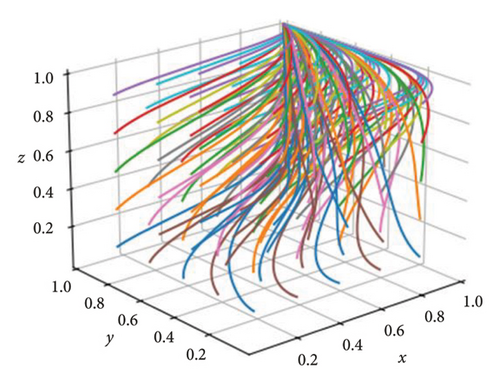
5.3. Simulation Analysis of Initial Distribution Impact Evolution Paths
5.3.1. Effect of Initial Probability of the Government on Evolutionary Paths
When the probability of the government adopting strict regulatory strategy increases from 0.1 to 0.9, the evolution results are shown in Figure 3. As the initial probability of the government adopting a strict regulation strategy increases, the evolution trend of the system accelerates, and the final evolution result tends to 1. This evolution result shows that the higher probability of strict government regulation will promote the use of blockchain technology by SNPs, providing a credible database for the traceability of public opinion events. SCMs will pay more attention to the development of public opinion events in the social circle under the strict regulation of the government, rationally express their views, and maintain the harmony and stability of social circle public opinion.
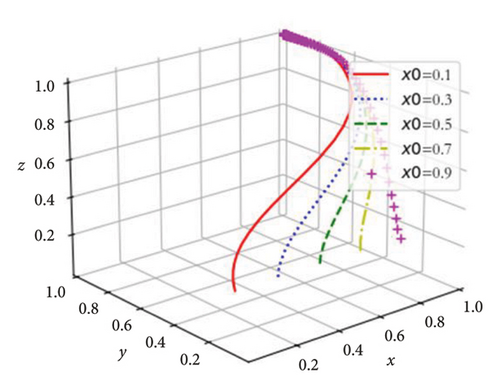
5.3.2. Effect of Initial Probability of SNPs on Evolutionary Paths
When the probability of SNPs adopting blockchain strategy increases from 0.1 to 0.9, the evolutionary result is shown in Figure 4. As the initial probability of SNPs adopting blockchain strategy increases, the evolutionary trend of the system accelerates, and the final evolutionary result tends to (1, 1, 1). This evolutionary result indicates that the higher the probability of SNPs adopting blockchain strategies, the higher the requirement for the government to strengthen regulation. This is because blockchain technology has risks such as data privacy and protection, compliance and regulation, etc., and the government can only reduce these risks and promote the sustainable development and application of blockchain technology by adopting timely and effective measures for rational regulation. The increase in the probability of SNPs adopting blockchain strategy will push SCMs to adopt the rational guidance strategy, which is because public opinion traceability enables SCMs to spend less cost to understand the real face of public opinion events and mobilize SCMs to participate.
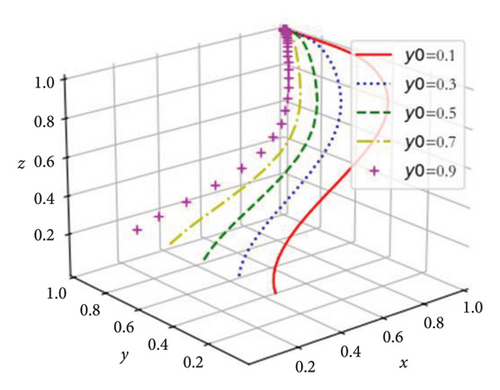
5.3.3. Effect of Initial Probability of SCMs on Evolutionary Paths
When the probability of SCMs adopting the rational guidance strategy increases from 0.1 to 0.9, the evolution results are shown in Figure 5. As the initial probability of SCMs adopting rational guidance strategies increases, the evolutionary trend of the system accelerates, and the final evolutionary result tends to (1, 1, 1). The evolution results show that the higher the probability of SCMs adopting rational guidance, the more favorable it is to the governance of public opinion in social circles. This is because SCMs, as the opinion leaders of public opinion in the social circle, will affect the ecology of the social circle if they leave the public opinion events unattended and do not take effective measures to govern them. Only by responding to the events positively and appropriately can SCMs dominate and guide the direction of public opinion to avoid the situation from further expanding.
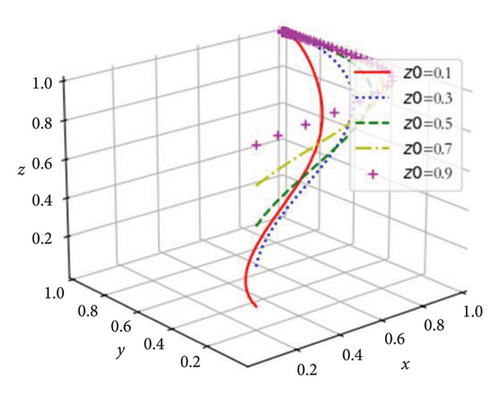
5.4. Simulation Analysis of Blockchain Technology Efficacy Changes
5.4.1. Changing Blockchain Technology R&D Costs Cp
In order to study the impact of Cp changes on the evolutionary game process and results, the simulation results of replicating the dynamic equation system evolving over time 50 times by decreasing Cp by 60%, keeping it the same, and increasing it by 60%, respectively, are shown in Figure 6. From the figure, it can be seen that the increase in the cost of blockchain technology development slows down the evolution of the government’s strategy of adopting strict regulation as the system evolves to stability. As Cp increases, the probability of SNPs using blockchain technology rises, and the probability of strict government regulation will show a decline, but over time, by weighing the long-term benefits, the government will still adopt a strict regulatory strategy. Therefore, the government can consider reducing R&D costs through measures such as cultivating technical talents and government-enterprise cooperation in R&D in order to increase the incentive to regulate.
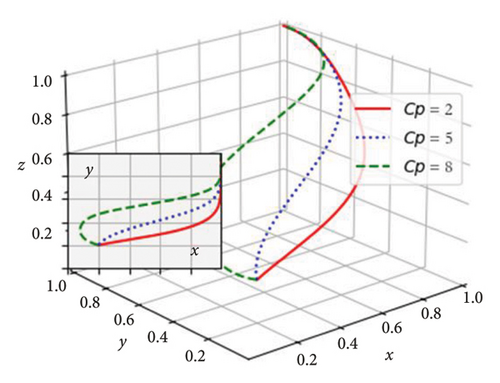
5.4.2. Change the Coefficient of Utility of Strict Regulation a1
In order to study the impact of a1 changes on the evolutionary game process and results, the simulation results of replicating the dynamic equation system evolving over time 50 times by decreasing a1 by 30%, keeping it unchanged, and increasing it by 30%, respectively, are shown in Figure 7. From the figure, it can be seen that in the process of system evolution to the stable point, the increase of the coefficient of utility of strict regulation a1 accelerates the evolution of the government to adopt the strategy of strict regulation. As a1 increases, the probability of strict government regulation increases and the probability of SNPs using blockchain technology increases. However, there is limited room for the coefficient of utility of strict regulation a1 to rise, which is because of the fact that the government adopts encouraging rather than mandatory policies for SNPs. If the government regulates SNPs more strictly and formulates a reasonable reward and punishment mechanism, it can increase the basic regulatory utility of the government. At the same time, the regulatory utility can be increased by encouraging SNPs to use blockchain technology, which can significantly improve the government’s credibility and realize the purpose of efficient regulation.
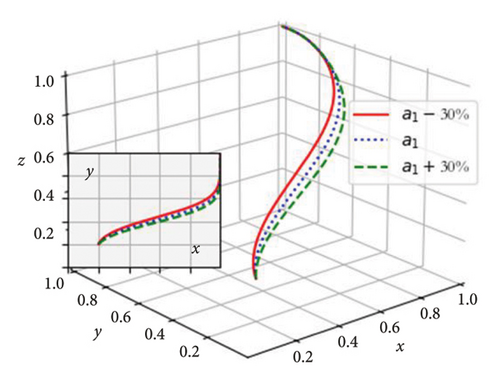
5.4.3. Changing Privacy Risks of Using Blockchain Technology V
In order to investigate the effect of V change on the evolutionary game process and outcome, the simulation results of replicating the dynamic equation system evolving over time 50 times by reducing V by 75%, keeping it constant and increasing it by 75%, respectively, are shown in Figure 8. From the figure, it can be seen that when the system evolves to a stable point, the increase in privacy risk posed by blockchain technology slows down the evolution of SNPs adopting blockchain strategies. As V increases, the probability of strict government regulation increases, and when V reaches a certain value, SNPs will not use blockchain technology. Therefore, the lower the privacy risk posed by blockchain technology, the stronger the willingness of SNPs to adopt blockchain strategies. The government can consider indirectly guiding SNPs to use blockchain technology by reducing the privacy risk posed by blockchain technology during the technology development process.
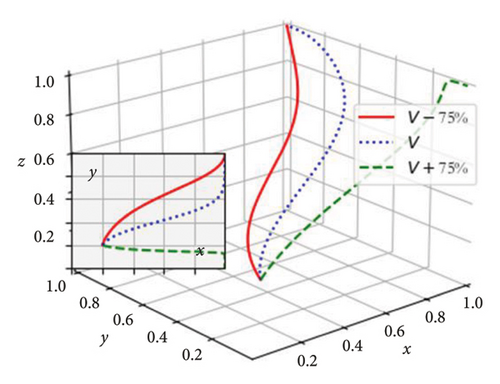
5.4.4. Changing Subsidies From Government E
In order to study the effect of the change of E on the process and outcome of the evolutionary game, the simulation results of replicating the dynamic equation system evolving over time 50 times by decreasing E by 90%, keeping it the same, and increasing it by 90%, respectively, are shown in Figure 9. From the figure, it can be seen that an increase in government subsidy E increases the evolutionary speed of SNPs adopting blockchain strategies as the system evolves to a stable point. As E increases, the probability of SNPs adopting blockchain strategies increases and the probability of strict government regulation decreases, but the final evolutionary equilibrium point is still (1, 1, 1). It can be seen that although the government’s subsidy mechanism for SNPs will reduce its own willingness to regulate, which is not conducive to the regulator’s own performance of its duties, the government has to focus on the benefits of a long-term good public opinion ecology from the perspective of long-term interests.

5.4.5. Change the Opinion Traceability Support Coefficient g2
In order to investigate the effect of g2 change on the evolutionary game process and results, the simulation results of replicating the dynamic equation system evolving over time 50 times by decreasing g2 by 75%, keeping it the same, and increasing it by 75%, respectively, are shown in Figure 10. From the figure, it can be seen that the increase of the opinion traceability support coefficient g2 improves the evolution speed of SCMs adopting the rational guidance strategy during the evolution of the system to the stabilization point. As g2 increases, the probability of SNPs adopting blockchain strategies increases, and the probability of SCMs leading rationally increases. It can be seen that applying blockchain technology to trusted data storage in social networks and using its advantages of tamper-proof, traceability, anonymity, and autonomy to achieve source tracking of public opinion information release and autonomous maintenance of the public opinion environment can mobilize SCMs to actively participate in public opinion governance and maintain the public opinion ecology in social circles.
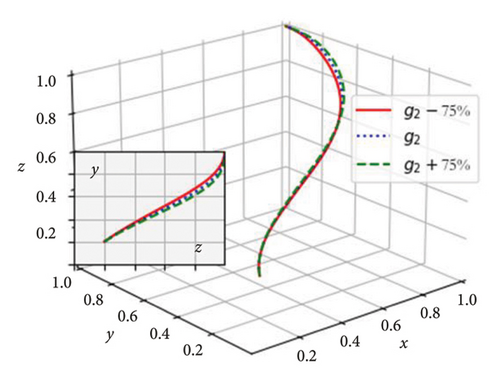
6. Conclusion and Management Insights
6.1. Discussion
- 1.
In the scenario where the government funds the construction of a blockchain platform, although the increase in construction costs may reduce the government’s incentive to regulate, the government’s decision-making does not only take into account its own interests but also places a high priority on the improvement of the level of social welfare. If blockchain technology can significantly improve the level of social welfare, the government may prioritize its long-term social benefits and ignore the short-term impact of construction costs.
- 2.
When the government creates economic barriers to the initial deployment and operation of blockchain technology, subsidies are used to encourage the active use of blockchain technology by SNPs. However, as the application of blockchain technology expands, the potential increase in privacy risks may raise concerns about data leakage and personal privacy protection, which in turn will offset the positive impact of government subsidies. Therefore, policy design needs to strike a balance between incentivizing technology adoption and privacy protection to ensure that SNPs can effectively manage and mitigate privacy risks while enjoying financial support.
- 3.
Blockchain technology significantly improves the rational guidance ability of SCMs by enabling the traceability of opinion data. Specifically, blockchain technology’s immutability and transparent record function enable the source of public opinion information, its propagation path, and its evolution to be accurately traced and verified. This technological empowerment enables SCMs to make more rational and data-driven decisions based on reliable opinion data. With the detailed information provided by blockchain, SCMs can more effectively identify key trends and potential risks in public opinion dynamics, thus implementing more precise and effective interventions in the face of public opinion crises. This not only helps to improve the scientific and objective nature of public opinion guidance but also enhances transparency and trust in the process of public policymaking.
6.2. Managerial Implication
- 1.
In the case of a government-funded blockchain platform, although the increase in construction costs may affect the government’s incentive to regulate, the government should focus its decision-making on the long-term enhancement of social welfare, rather than considering only short-term cost issues. In order to promote the effective application of blockchain technology, the government should take multifaceted measures to support technology development and application. For example, the government can set up special funds and incentives to encourage R&D and innovation of blockchain technology, and collaborate with universities and research institutes to carry out technological research. At the same time, the government should strengthen public education and publicity on blockchain technology, enhance social awareness and acceptance of the technology, and help the public understand the social value and potential benefits of blockchain through popularization activities and publicity lectures.
- 2.
In order to incentivize the positive application of blockchain technology, SNPs need to establish a user participation and feedback mechanism to understand user needs and make corresponding improvements through a user feedback platform and regular user surveys to enhance user trust. Meanwhile, SNPs should publicize key information and privacy protection measures in the application of blockchain technology to ensure the security of user data. In addition, SNPs can support public welfare projects through blockchain technology to enhance corporate social responsibility and cooperate with nonprofit organizations and communities to solve social problems using blockchain technology, promote the social application of the technology, and enhance brand image and social influence.
- 3.
SCMs play an important role in social networks, and they should utilize blockchain public opinion traceability technology to understand the beginning and end of network public opinion events, and fully understand and monitor public opinion trends. Through close cooperation with the government and SNPs, they can share data and information, establish an effective public opinion response mechanism, and respond to possible public opinion crises and challenges in a timely manner. In addition, SCMs should actively advocate information transparency and truthfulness through public education and moral guidance, and promote the formation of rational and objective public opinion attitudes among the public, so as to jointly purify the ecology of public opinion on social networks and contribute to the harmony and stability of society.
However, there are several significant shortcomings in the existing research. The theoretical deepening and empirical validation are not sufficient, and the specific mechanisms and paths of blockchain technology’s impact on the effectiveness of public opinion traceability have not been explored in depth; the technological innovations and application strategies are still incomplete, especially in the protection of data privacy and optimization of system performance; and there is a lack of research on the adaptability of blockchain technology in different cultures and social backgrounds, and the promotion of its application on a global scale and empirical research on policy implications. Future research should strengthen the exploration of these aspects and conduct in-depth studies on the application effects and long-term impacts of blockchain technology in the collaborative governance of online public opinion in the social circle, especially the effectiveness in enhancing the credibility of public opinion information, strengthening the security of data, purifying the public opinion ecosystem, and effectively guiding public opinion. In addition, it is necessary to optimize the technological innovation and application strategies of the blockchain public opinion traceability system, including but not limited to performance optimization, improvement of data privacy protection mechanism, and deep integration with other cutting-edge technologies such as artificial intelligence and big data analysis. Future research should also examine the adaptability and sustainable development strategies of blockchain technology in different sociocultural contexts and explore its promotion and application globally, as well as its impact on policymaking and governance models. These efforts will provide theoretical support and practical guidance for building an intelligent, efficient, and credible public opinion management mechanism, and promote the healthy development and stability of the social information environment.
Conflicts of Interest
The authors declare no conflicts of interest.
Funding
This research was funded by the Philosophy and Social Science Foundation of Heilongjiang Province (Subject number: 22GLB105).
Acknowledgments
This research was funded by the Philosophy and Social Science Foundation of Heilongjiang Province (Subject number: 22GLB105).
Open Research
Data Availability Statement
The data that support the findings of this study are available on request from the corresponding author. The data are not publicly available due to privacy or ethical restrictions.




